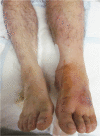Chromobacterium haemolyticum-induced bacteremia in a healthy young man
- PMID: 24004824
- PMCID: PMC3766243
- DOI: 10.1186/1471-2334-13-406
Chromobacterium haemolyticum-induced bacteremia in a healthy young man
Abstract
Background: The genus Chromobacterium consists of 7 recognized species. Among those, only C. violaceum, commonly found in the soil and water of tropical and subtropical regions, has been shown to cause human infection. Although human infection is rare, C. violaceum can cause life-threatening sepsis, with metastatic abscesses, most frequently infecting those who are young and healthy.
Case presentation: We recently identified a case of severe bacteremia caused by Chromobacterium haemolyticum infection in a healthy young patient following trauma and exposure to river water, in Japan. The patient developed necrotizing fasciitis that was successfully treated with a fasciotomy and intravenous ciprofloxacin and gentamicin.
Conclusions: C. haemolyticum should be considered in the differential diagnosis of skin lesions that progressively worsen after trauma involving exposure to river or lake water, even in temperate regions. Second, early blood cultures for the isolation and identification of the causative organism were important for initiating proper antimicrobial therapy.
Figures


References
-
- Soby SD, Gadagkar SR, Contreras C, Caruso FL. Chromobacterium vaccinii sp. nov. isolated from native and cultivated cranberry (Vaccinium macrocarpon Ait.) bogs and irrigation ponds. Int J Syst Evol Microbiol. 2012;63:1840–1846. - PubMed
Publication types
MeSH terms
LinkOut - more resources
Full Text Sources
Other Literature Sources

